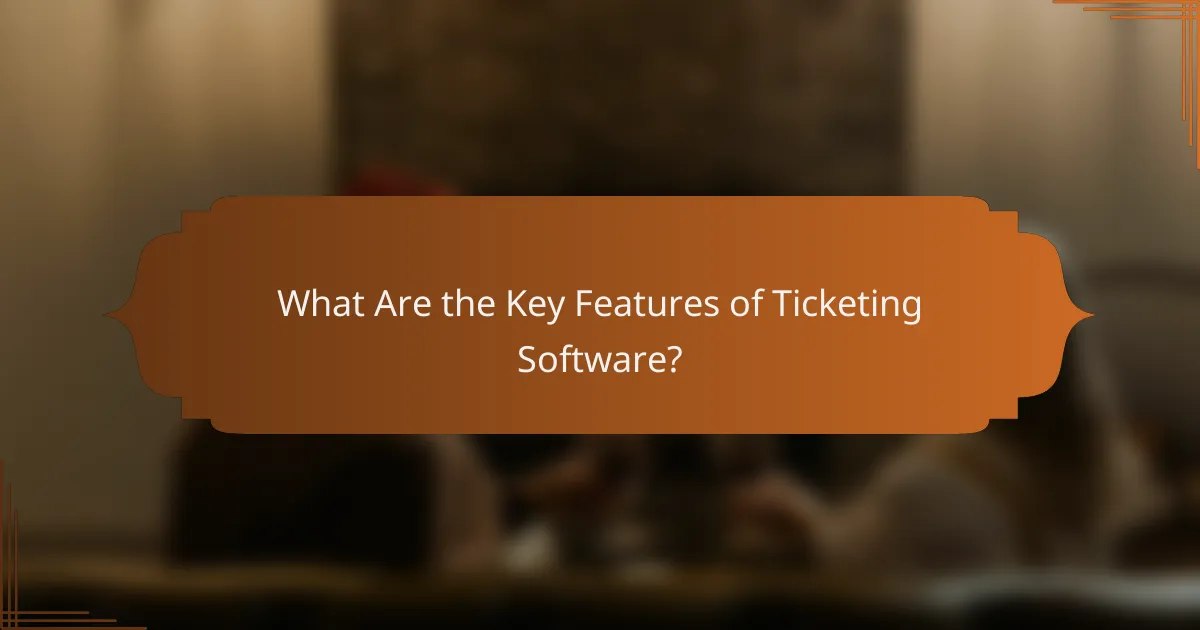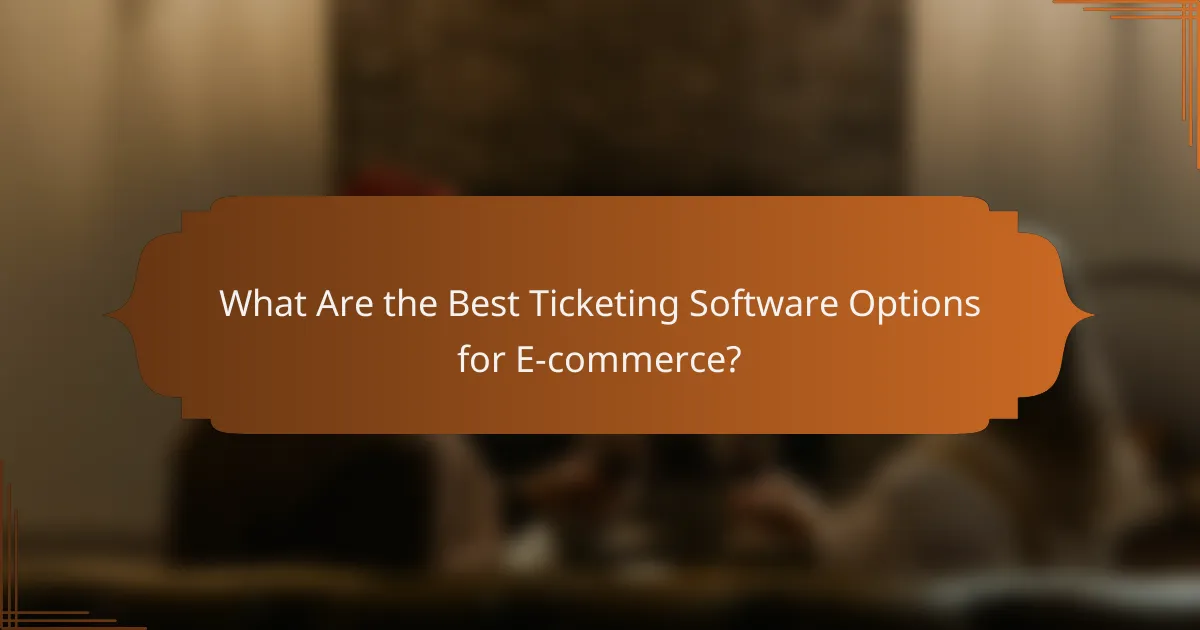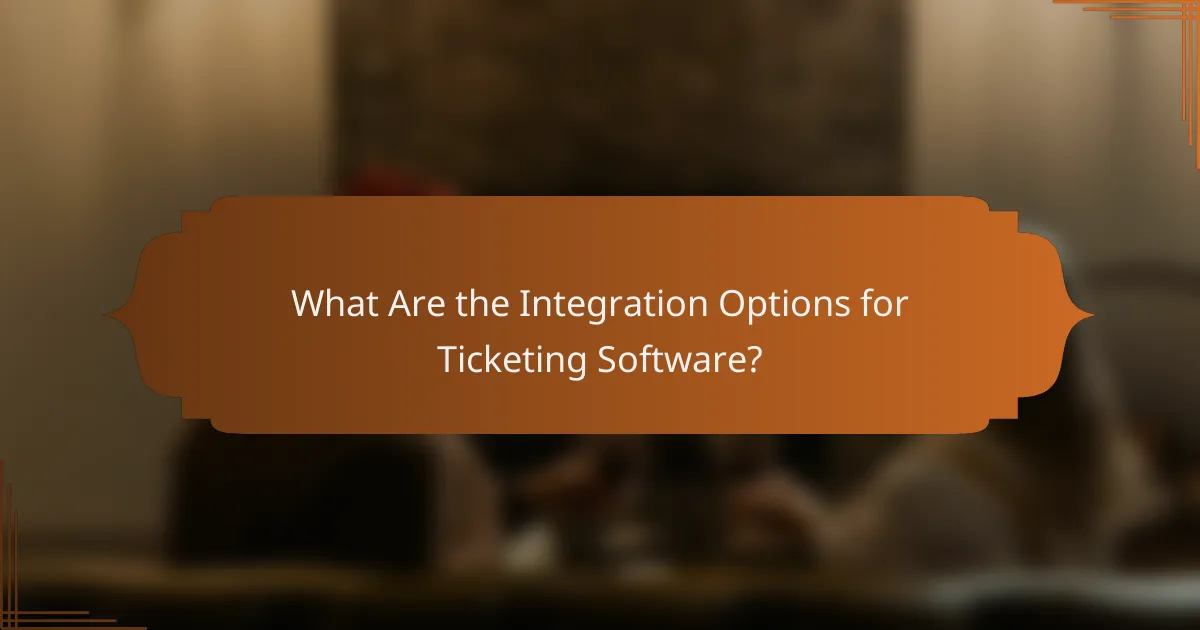Ticketing software plays a crucial role in event management by offering essential features that streamline operations and enhance user experience. With functionalities such as real-time inventory management, customizable ticket types, and automated payment processing, these platforms facilitate seamless transactions for both organizers and attendees. A strong focus on user experience can significantly boost customer satisfaction and drive repeat business, making it vital for platforms to integrate effectively with e-commerce solutions.

What Are the Key Features of Ticketing Software?
Ticketing software typically includes essential features that streamline event management, enhance user experience, and improve operational efficiency. Key functionalities include real-time inventory management, customizable ticket types, automated payment processing, reporting and analytics tools, and mobile accessibility.
Real-time Inventory Management
Real-time inventory management allows event organizers to track ticket availability instantly. This feature ensures that users can see how many tickets are left, reducing the risk of overselling and improving customer satisfaction.
Effective inventory management systems often integrate with sales channels, updating ticket counts automatically as purchases are made. This helps maintain accurate records and provides insights into demand trends.
Customizable Ticket Types
Customizable ticket types enable organizers to create various ticket categories tailored to different audience segments. Options may include general admission, VIP packages, early bird discounts, and group rates.
Offering diverse ticket types can enhance revenue by appealing to a broader audience. Consider setting different price points based on features or access levels to maximize sales potential.
Automated Payment Processing
Automated payment processing simplifies transactions by securely handling payments without manual intervention. This feature typically supports multiple payment methods, including credit cards, digital wallets, and bank transfers.
Choosing a ticketing software with robust payment processing can help reduce transaction times and minimize errors. Look for solutions that comply with PCI standards to ensure customer data security.
Reporting and Analytics Tools
Reporting and analytics tools provide valuable insights into ticket sales, customer demographics, and event performance. These features help organizers make data-driven decisions for future events.
Effective reporting tools often include customizable dashboards and export options, allowing users to analyze data in various formats. Regularly reviewing these metrics can help identify trends and optimize marketing strategies.
Mobile Accessibility
Mobile accessibility ensures that users can purchase tickets and access event information from their smartphones or tablets. This feature is crucial as many customers prefer mobile transactions for convenience.
When selecting ticketing software, prioritize platforms that offer mobile-friendly interfaces and apps. This can enhance user experience and potentially increase ticket sales, as customers can buy tickets anytime, anywhere.

How Does User Experience Impact Ticketing Software?
User experience (UX) significantly influences the effectiveness of ticketing software by determining how easily users can navigate the platform and complete transactions. A positive UX can lead to higher customer satisfaction, increased sales, and repeat business.
Intuitive User Interface
An intuitive user interface (UI) is crucial for ticketing software as it allows users to find information quickly and efficiently. Key elements include clear navigation, logical layout, and visually appealing design. For instance, using recognizable icons and consistent terminology can enhance usability.
When evaluating ticketing software, look for features like customizable dashboards and easy access to event details. A well-designed UI can reduce the learning curve for new users and minimize errors during the ticket purchasing process.
Streamlined Checkout Process
A streamlined checkout process is essential for converting potential buyers into actual customers. This involves minimizing the number of steps required to complete a purchase and offering multiple payment options, such as credit cards, PayPal, or local payment methods like BGN for Bulgarian users.
Consider implementing features like guest checkout and auto-fill for returning customers to speed up the process. Avoid unnecessary fields that can frustrate users and lead to cart abandonment.
Customer Support Accessibility
Accessible customer support is vital for resolving issues that may arise during the ticket purchasing journey. Offering multiple channels, such as live chat, email, and phone support, ensures that users can get help when they need it. Quick response times can significantly enhance user satisfaction.
Additionally, providing a comprehensive FAQ section and user guides can empower customers to find solutions independently. Regularly updating these resources based on user feedback can further improve the overall experience.

What Are the Best Ticketing Software Options for E-commerce?
The best ticketing software options for e-commerce include platforms that streamline the ticket purchasing process, enhance user experience, and offer robust integration capabilities. Key players in this space are Eventbrite, Ticketmaster, and Brown Paper Tickets, each providing unique features tailored to different needs.
Eventbrite
Eventbrite is a popular choice for e-commerce ticketing, known for its user-friendly interface and extensive promotional tools. It allows event organizers to create, manage, and sell tickets online with ease, offering features like customizable event pages and social media integration.
Consider using Eventbrite if you need a platform that supports a variety of event types, from concerts to workshops. Its pricing model typically includes a service fee per ticket sold, which can vary based on the ticket price, making it suitable for both small and large events.
Ticketmaster
Ticketmaster is one of the largest ticketing platforms, ideal for high-demand events such as concerts and sports. It provides advanced features like dynamic pricing and a robust mobile app, ensuring a seamless purchasing experience for users.
When choosing Ticketmaster, be aware of its higher fees compared to other platforms, which can impact overall ticket pricing. However, its extensive reach and brand recognition can lead to increased sales, especially for major events.
Brown Paper Tickets
Brown Paper Tickets offers a cost-effective solution for event organizers, with no upfront fees and a low service charge per ticket sold. This platform is particularly appealing for smaller events or non-profit organizations looking to minimize costs.
Using Brown Paper Tickets, you can benefit from features like customizable ticket types and promotional tools. However, its user interface may not be as polished as competitors, so consider your audience’s needs when selecting this option.

How to Choose the Right Ticketing Software?
Choosing the right ticketing software involves assessing your specific business needs, comparing pricing models, and evaluating integration capabilities. A well-suited ticketing system can streamline operations, enhance customer experience, and improve overall efficiency.
Assessing Business Needs
Start by identifying the unique requirements of your organization. Consider factors such as the volume of tickets, types of events or services, and user roles within your team. For instance, a small event organizer may prioritize ease of use and affordability, while a large enterprise might need advanced features like multi-channel support and analytics.
Engage with key stakeholders to gather insights on their expectations. This can help you prioritize essential features such as mobile access, customer relationship management (CRM) integration, and reporting capabilities. Documenting these needs will guide your selection process effectively.
Comparing Pricing Models
Ticketing software typically offers various pricing models, including subscription-based, pay-per-ticket, and one-time purchase options. Subscription models often provide ongoing support and updates, while pay-per-ticket can be cost-effective for organizations with fluctuating demand.
Evaluate the total cost of ownership, including hidden fees for features like payment processing or customer support. Comparing multiple vendors can reveal significant differences in pricing structures, helping you find a solution that fits your budget while meeting your needs.
Evaluating Integration Capabilities
Integration capabilities are crucial for ensuring your ticketing software works seamlessly with existing systems, such as CRM, marketing tools, and accounting software. Look for solutions that offer APIs or built-in integrations to facilitate data sharing across platforms.
Consider how well the software can adapt to your current technology stack. For example, if you use a specific payment processor, ensure that the ticketing system supports it. Testing integrations during a trial period can help identify any potential challenges before committing to a long-term solution.

What Are the Integration Options for Ticketing Software?
Integration options for ticketing software are essential for streamlining operations and enhancing user experience. These integrations typically include payment gateways, customer relationship management (CRM) systems, and marketing tools, allowing businesses to manage sales and customer interactions more efficiently.
Payment Gateway Integrations
Payment gateway integrations enable ticketing software to process transactions securely and efficiently. Common options include PayPal, Stripe, and Square, which facilitate online payments and provide various features like fraud protection and multi-currency support.
When selecting a payment gateway, consider transaction fees, ease of integration, and the payment methods supported. For instance, some gateways may charge a percentage of each sale, while others have flat fees, so it’s crucial to evaluate which model aligns with your business needs.
To ensure a smooth user experience, test the payment process thoroughly before going live. Common pitfalls include not optimizing for mobile devices or failing to provide clear payment instructions, which can lead to abandoned transactions.



